

West Jordan resident makes wickedly good treats on Food Network’s Halloween Baking Championship
By Peri Kinder | peri.k@thecityjournals.com
Local baker uses plenty of imagination to whip up haunting desserts.
Melanie Bjork-Jensen has a tattoo that reads, “I am worth the effort it takes to be happy.” That motto was put to the test when she was selected to be a contestant on the 11th season of Food Network’s Halloween Baking Championship.
The West Jordan resident was one of 10 bakers from around the country who competed on the seven-episode show, vying for the chance to win $25,000. Set in a haunted mansion, the Halloween Baking Championship created terrifying competitions for the contestants. The first baking test challenged bakers to depict their number one Halloween fright, and make it pump blood.
“We were given tubing and a pump, and we had to make the blood edible and match the flavor of our creation and be able to slide the tubing through without messing up the dessert,” she said. “We had to do it live on camera, in front of the judges, and it was so terrifying.”
Bjork-Jensen taught herself to bake by watching YouTube videos. She began making wedding cakes, built up a clientele and used the money she earned to pay her way through nursing school. She worked as a trauma nurse before becoming a traveling labor-and-delivery nurse, currently working at St. Mark’s Hospital in Millcreek.
This was her second time applying for the Halloween Baking Championship. This year, Bjork-Jensen was contacted by the show’s producers to see if she was still interested. She was definitely still interested.
Filming the show was intense. Bjork-Jensen said she felt trauma-bonded to the other contestants, whom she loved getting to know, and even had a well-publicized meltdown on set during one of the challenges.
“I have a background as an emergency nurse, but I feel like [the show] brought me to the breaking point,” she said. “It was also an amazing experience. It was fun and unlike anything I’d done before.”
Bjork-Jensen survived a brain tumor four years ago, but it left her with Hashimoto’s, an autoimmune disease that affects the

thyroid gland. The disease is exacerbated by gluten, so baking on the show became a challenge because she couldn’t taste the items she was making.
In one episode, she knew her recipe was wrong, but she wasn’t sure what she’d missed. She decided to take a bite, then spit it out to see if she could pinpoint her mistake.
“I had left the sugar out. It was terrible.”
Bjork-Jensen said her two children have been her biggest cheerleaders. They were able to fly to California on a day she wasn’t filming to hang out and they’ve told all their school friends about her baking skills.
“I tend to be unkind to myself and I haven’t been very patient with myself, like allowing myself to learn new things. So being able to give myself the right to do poorly and learn and to do better shows I’m worth the effort,” she said. “Going through this felt like the biggest piece of therapy that I could have, and it was an incredible life-changing experience.”
Season 11 of Food Network’s Halloween Baking Championship premiered on Sept. 15 and is currently available on Food Network and streaming services. l
Although she compared the experience to “water torture,” she found value in the effort and the time she took off work to do something important. She permitted herself to enjoy the experience, acknowledging that it was okay to do something for herself.



Melanie Bjork-Jensen, a West Jordan wedding cake baker and labor-and-delivery nurse, competes on season 11 of Food Network’s Halloween Baking Championship. (Photo courtesy Food Network)



Treating your whole family tree.

Holy Cross Hospitals have been trusted by Utah families since 1875.
For 150 years, Holy Cross Hospitals have cared for Utah families in their most tender, powerful, and vulnerable moments. From newborn checkups to post-op recoveries, we’ve seen generations through their highest highs and hardest days.
We’ve done it all with one purpose: to treat people, not just patients. We care for every person with personalized treatment powered by compassion and respect.
Our belief that we all hold the power to heal helps us provide care that spans generations and stands the test of time.
Learn more at mountain.commonspirit.org/holycross150.
Chalk the Walk brings color to the community
Dozens of entries covered the plaza at the Viridian Event Center in West Jordan.
By Peri Kinder peri.k@thecityjournals.com
Chalk the Walk transformed the Viridian Event Center’s outdoor plaza into a vibrant gallery with nearly 60 chalk art entries. On Aug. 30, artists of all ages and abilities gathered at the center, spending hours creating their displays.
“It’s a chance for the community to come together and see some art and we have a bunch of different age categories, from youth all the way up to adult,” Sarin Wesel said, Viridian’s event coordinator. “It’s an opportunity for people to try chalk
art in a low-stakes environment and have fun with it.”
In partnership with West Jordan City, the Viridian Event Center created the free Chalk the Walk event and provided materials for all entrants. Displays made by artists under 12 were not judged; instead, the youth were given the chance to try out the medium, stretch their abilities and learn from more experienced artists.
Everleigh Curran, 15, is a Millcreek chalk artist. She participated in last year’s Chalk the Walk event and found she had a real skill for it. She said her tribute to “The Cat in the Hat” was simpler than other designs she’d created, but she loved the characters.
“I also am an artist, so I like drawing and I like using stuff that I can blend. So, that’s what got me interested in this,” Ever-

leigh said.
Quinnley Starr is a regular at Chalk the Walk, winning last year’s adult team category with Patrick Wilkerson and her sister, Winter Starr. This year was the first time she entered as an individual artist.
Starr said she enjoys the chalk art challenge because it allows her to focus on one thing, almost like meditation, making the
eight hours of design time fly by. Her piece, “The Wild Robot,” was an acknowledgment of emotion, human and otherwise.
“I love ‘The Wild Robot,’” Starr said. “It makes me cry whenever I watch it. It’s so sweet. It’s so good. I have discovered, through doing lots of chalk art competitions, that people like colorful chalk art that brings out emotion or makes them think about something they love, like a good movie. I like the color on the duck and on the robot space, where it’s lighting up with love and joy. It brings your attention there.”

Community members were invited to add their own chalk design to the wall around the plaza while enjoying the dozens of chalk art entries.
After all the votes were counted, Trisha Bhatia won the People’s Choice award; Nichole Kleinman took first in the Adult Solo category; Lexie Daley and Tee Jorgensen won the Adult Team division; Drako Woodland finished first in Teen Solo; Sophie Brewer and Sarah Hooper took the top prize for Teen Team; and Carl Brewer, Tesla Brewer and Atlas Brewer finished first in the All Ages category.
“We have some regulars that come every year and are part of the chalk community, so everyone gets a chance to meet new people,” Wesel said. “It draws people into that community and we were able to draw in some of the library patrons. They came to the library and they saw something going on, and they came and got to participate in the community activity.” l
The West Jordan Journal is a monthly publication distributed directly to residents via the USPS as well as locations throughout West Jordan.
For information about distribution please email hello@thecityjournals.com or call our offices. Rack locations are also available on our website. The views and opinions expressed in display advertisements do not necessarily reflect or represent the views and opinions held by Loyal Perch Media or the City Journals. This publication may not be reproduced in whole or in part without the express written consent of the owner. © 2019 Loyal Perch Media, Inc.
Bryan Scott | bryan.s@thecityjournals.com
EDITOR
Travis Barton | travis.b@thecityjournals.com
ADVERTISING EXECUTIVES
Mieka Sawatzki | mieka.s@thecityjournals.com
Lindsay Andreasen | lindsay.a@thecityjournals.com
Jason Corbridge | jason.c@thecityjournals.com
Ryan Casper | ryan.c@thecityjournals.com
Marc Davis | marc.d@thecityjournals.com
Lydia Rice | lydia.r@thecityjournals.com 385-557-1022
Rack
9500 South 500 West, Suite 205 Sandy, UT 84070
PHONE: 801-254-5974

WEST JORDAN TEAM
Quinnley Starr chalked a tribute to “The Wild Robot” during the Chalk the Walk event at the Viridian Event Center in West Jordan. (Peri Kinder/City Journals)
“The Cat in the Hat” took center stage in Everleigh Curran’s chalk art entry. (Peri Kinder/City Journals)
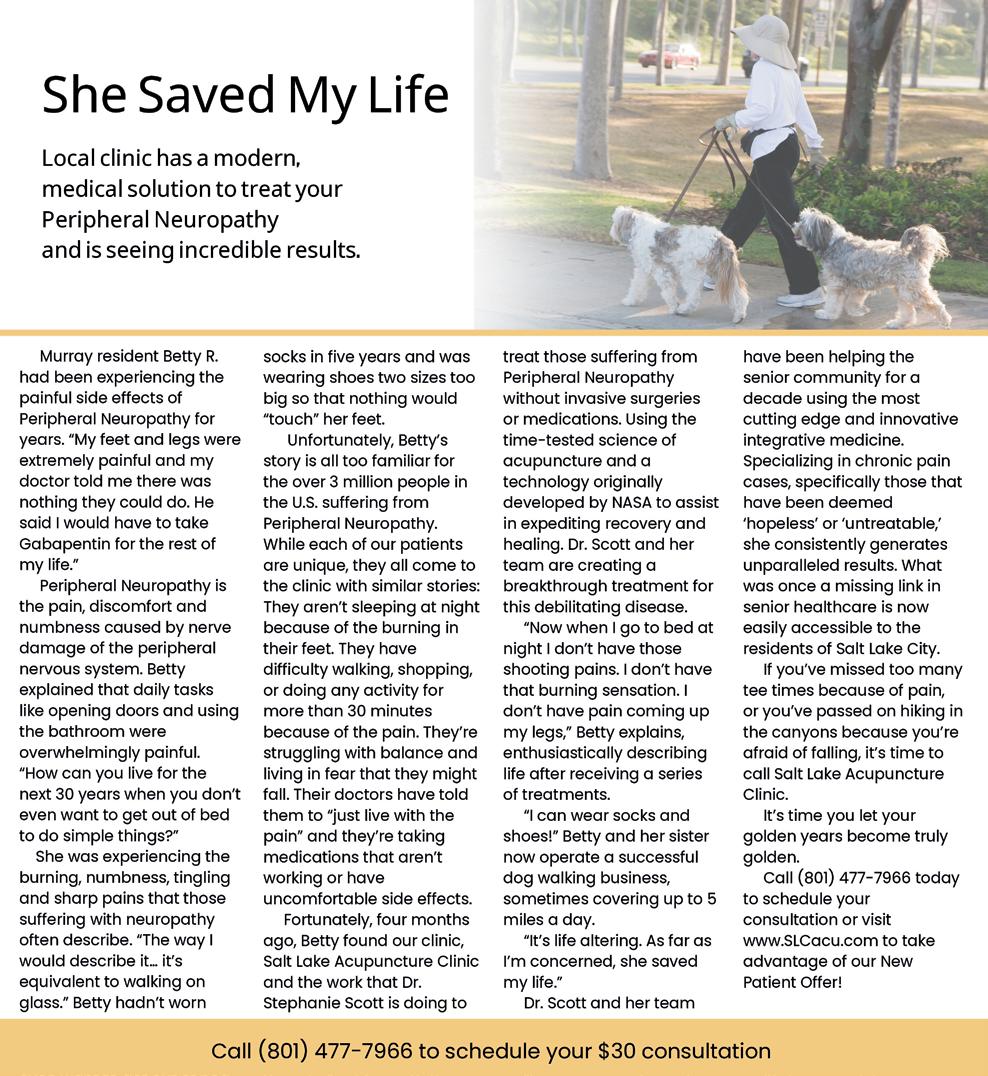
The attendance connection
Local educators try a variety of strategies to reduce chronic absenteeism rates.
By Jet Burnham j.burnham@mycityjournals.com
This is part of a series on school attendance.
Last month, the Utah State Board of Education launched the attendance initiative Every Day Counts to address chronic absenteeism rates, which rose from 12.5% to 23.8% in the past seven years. Their research shows chronic absenteeism (defined as 10% of school days missed or two absences per month) has academic, social and emotional impacts on students and results in lower grades, test scores, graduation rates and confidence.
“Each school day is an opportunity for students to learn, build relationships and grow in meaningful ways,” Utah State Superintendent Molly Hart said.
USBE provided an online toolkit and resources for families and educators to address factors which impact student attendance. They also enlisted the help of Attendance Ambassadors in every school district.
West Hills Middle School teacher Evan Feinberg jumped at the chance to be Jordan School District’s Attendance Ambassador. Feinberg is full of ideas to proactively improve attendance rates; he has implemented many already at West Hills Middle. Two years ago, he formed an attendance committee and got several staff members onboard to address and improve student attendance.
Feinberg collaborated with WHMS Clinical Support Specialist Andrew “Link” Simpson and Head School Counselor Brian Behrmann to hold weekly attendance groups targeting students with poor attendance, and last year, the number of chronically absent students decreased by 7%.
In the groups, students learn about their brain development and how to connect their actions to future consequences.
“We focus more on just life skills that will benefit them later on, to try to connect attendance to more success later on, with learning to show up on time and working with different personalities—those skills that you need for any job,” Behrmann said.
They also help students see the benefits of good attendance habits on their mental health.
“The more absences they have, the farther they get behind and then I think they just start to give up because they don’t have a clue what’s going on in class, and it’s easier for them to not be in class than have the anxiety of being called on and not
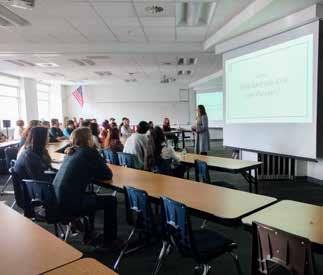

Chronic absences affect students’ academic, social and mental growth. (Jet Burnham/City Journals)
knowing the answer,” Simpson said.
The students track their academic progress in correlation to their attendance and when there is improvement, their progress is celebrated.
WHMS staff members take a positive and encouraging approach to attendance problems to prevent the problem from becoming worse.
“If the family doesn’t have a connection to school, and its punitive talks back and forth between the school and the family, that decreases that home-school connection, and it continues to get worse and worse and so it’s pushed the families away from the school so the parents don’t push their kids to attend as much as they normally would,” Simpson said.
West Jordan Middle School has also had immense success improving student attendance by building positive connections with students and families. Their 0.6% chronic absenteeism rate is the lowest in Jordan School District (district average is 23%) and one of the lowest in the state. Principal Raimee Jensen credits the low rate to the team effort by teachers, administrators, counselors, office staff and SROs to make connections with students and families.
Most JSD school policies stipulate a student’s parents are contacted by letter or email after a certain number of consecutive absences. When WJMS students don’t show up at school, school staff members don’t wait the prescribed number of days before they start calling, emailing and visiting the student’s home to work with the family to resolve the root causes.
“It’s really about creating a culture where students know that they matter and that their presence makes a difference,” Jensen said. “We’re intentional about fostering a sense of belonging, because we know students are more likely to show up when they feel seen, supported and valued.”
Rae Garrison (WJMS principal 2013-2023) said the school’s robust teacher-led after-school program, the biggest in the state, offers ‘every club you can think of.’ She said it gives students a reason to come to school and an opportunity to develop relationships with their teachers through shared interests.
Missing 2 Days a Month can Knock You Off Course

Show Up | Stay On Track | Graduate Together
Join the State-Wide Attendance Challenge!

Utah State Board of Education poster emphasizes the importance of regular school attendance. (USBE)
“Students are able to connect with their teachers in a little different way,” Garrison said. “It could be playing Dungeons & Dragons or e-sports or volleyball—and that kind of connection really helps because it’s not about ‘Did you get your homework done?’ it’s more about ‘Hey, how’re you doing?’”
While WHMS and WJMS take a positive approach to attendance, many schools effectively discourage poor attendance with punitive policies. Most schools deny students with excessive school absences from participating in extracurricular activities, attending school dances and activities or obtaining a school parking pass. Granite School District goes so far as to fine truant students.
This year, Bingham High School announced a new policy in which 10% of a student’s overall academic grade is correlated to their class attendance. At Herriman High School, students lose points with each unexcused absence or tardy, reflected in the participation portion of their grade, which can be 10-20% of the final grade. Both schools also incentivize students with free school merch and treats for good attendance each quarter.
Utah’s 45th district representative Tracy Miller, previous president of the Jordan School District Board of Education, said the removal of state truancy laws several years ago, coupled with the increased flexibility of virtual education options in recent years, have contributed to the current attendance problems.
“There’s just a different attitude about schools and about the importance of attendance in schools,” Miller said. “But any teacher will tell you it’s really difficult to teach the student that doesn’t show up.”
She said state legislators are discussing solutions for school attendance problems.
“We don’t want to really come down hard on kids, because a lot of them are dealing with a lot of issues,” Miller said. “We want to really help kids as best we can, so, there’s got to be a balance between helping them and holding them accountable at the same time, and so figuring out that balance is the key.” l
Teachers can’t teach students who aren’t in class. (Jet Burnham/ City Journals)

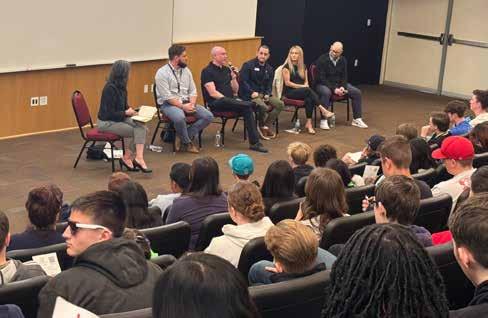
Pathway to the future
Students get an early start on career planning and a headstart on their education through proactive CTE programs.
By Jet Burnham j.burnham@mycityjournals.com
Inmiddle school classrooms around the state, students are unlocking the answer to one of the most common questions they get asked—‘What do you want to be when you grow up?’
Throughout middle school, Career and Technology Education and counseling departments work together to encourage students to think about their future. They provide opportunities for them to explore their interests, expose them to a variety of career options and connect them with classes and experiences that will take them where they want to go.
“We start at a young age to get them thinking all throughout their middle school and high school career, ‘What are your plans for high school and beyond?’” Fort Herriman Middle School Counselor Chris Montague said. “We are starting with our seventh graders and right now it’s more of, ‘Do you like science? Do you like math? Do you like art?’ And that way we can start using that to plant those seeds to figure out what’s the next step.”
Each October, seventh graders complete YouScience, a state aptitude and interest assessment, to provide insight into their abilities and interests. Eighth graders are invited to CTE field trips based on their YouScience results. In ninth grade, students take another assessment which yields a detailed 15-page report to help them register for high school classes that support their interests, skills and career and education goals.
“The goal is that we don’t have a bunch of graduates who don’t know what they want
to do, thinking ‘I should have taken this class,’ or ‘I should’ve taken that class,’” Jordan School District CTE Consultant Julie Scherzinger said.
The CTE pathway programs take a proactive approach in helping students identify a career in which they excel and enjoy.
“A student might show an aptitude in computer science and not even know it unless they take a class where they’re exposed to something that’s computer science, then all of a sudden they realize it is really easy for them,” Scherzinger said. “We’re trying to manufacture those experiences much earlier in life for them now.”
Through CTE department career-connected events and CTE field trips, students are introduced to careers they may never have considered and to jobs they never knew existed.
Last spring, 400 students who scored high in financial aptitude were invited to a finance career event. According to their assessments, only 117 of them were actually interested in finance.
Representatives from an auto dealership, sports stadium construction company, professional theater and the hospitality and tourism industry gave presentations on the finance-related jobs in their industries, which appealed to students with interests in performing arts, sports, construction, cars, tourism and travel.
“If I’m a kid who is only interested in auto shop, and they’ve got somebody there from the Lamborghini place, and he’s talking about how you can work in the auto industry doing all the financing for the cars—all of a sudden, you’re marrying their two worlds— their interests along with their aptitude,” Scherzinger said.
Throughout this year, students will be identified based on their YouScience results and invited to events exploring careers in education, computer science, agriculture, STEM
and construction.
Scherzinger said CTE programs that line up with students’ interests and abilities are the solution to common high school problems such as poor attendance, low engagement and opting out of full schedules during senior year.
“When you put the right kids in the right experience, they are fully engaged,” she said. “It’s kind of a Jedi trick. We know they’re going to love it before they know they’re going to love it because YouScience has already told us they’re going to love it.”
A CTE career connected event scheduled in November will highlight teaching jobs other than a traditional school teacher. Eighth and ninth grade students will learn what it’s like to be a school superintendent, school board member, education lawyer, speech pathologist, school counselor and sports team coach.
“What we’re doing is just trying to really build out this exciting pathway of teacher education and let students know that it can lead to multiple careers,” Scherzinger said.
For students wanting to jumpstart their career-related education, JSD offers several career pathways which begin in middle school with basic classes and advance to college-level courses in high school.
This year, Mountain Ridge High School offers the only Principles of Education Instruction class in the district, the final step in the teaching pathway, which creates a complete and seamless K12 Teaching As a Profession pathway in the Mountain Ridge High School cone (or feeder system.)
“That’s the whole goal, is that we can create these pathways and be very intentional in our activities that really connect the dots for the students,” Scherzinger said.
The seamless progression from middle school student to a teaching career doesn’t stop at high school graduation. This year, JSD hired a University of Utah student as a teacher apprentice through a USBE-sponsored
apprenticeship program with the Department of Labor. The teacher-in-training works alongside a licensed special educator at a Jordan District school while earning their degree. Scherzinger said the successful outcomes of students who follow a career pathway is something everyone can celebrate.
“If they’re getting in the pathway earlier through these course selections in ninth, tenth and eleventh grade, and that leaves their senior year to do internships and apprenticeships and connect to industry partners, and really give them that bridge to post secondary—whether that’s going to be higher education, an apprenticeship or a certification of some sort—that’s really going to help build Utah’s economy,” she said. l
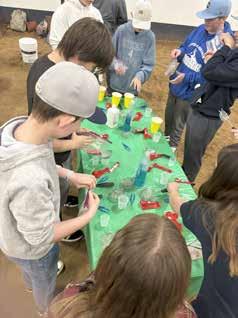
Middle School students participate in hands-on activities to learn about agriculture-related jobs.. (Photo courtesy Julie Scherzinger)
Students learn first-hand about a variety of construction jobs from those currently working in the industry. (Photo courtesy Julie Scherzinger)
A panel of industry representatives answer students’ questions about their jobs. (Photo courtesy Julie Scherzinger)


Extraordinary band experiences take center stage
CHHS band director provides various unique experiences to sharpen band students’ skills and deepen their connection to music.
By Jet Burnham j.burnham@mycityjournals.com
to blow their own horn, but the Copper Hills High School marching band performed at a popular summer music concert and, well, blew their own horns for the finale.
On July 22, 105 CHHS band students marched onto the stage and into the aisles of Utah First Credit Union Amphitheatre to join the touring pop band AJR in a show stopping encore number, a mashup of several of the group’s most popular songs, to end the concert with a spectacular bang.
“Everyone was beaming about it, everyone was so excited,” drum major/mellophone player Adam Corbine said. “When we got out there and we did it, it was the coolest feeling I’ve ever had. It was indescribable.”
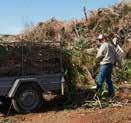
CHHS senior Eden Nicolaysen, who, as drum major/mellophone player, usually plays for audiences of a few hundred, said playing for an enthusiastic crowd of 13,000 was a new experience.
“Just seeing the reactions of people around me and how excited they were just kind of made me feel happy that we were able to provide them with this experience, and to have them feel the same thing that we were, that they were also part of this once-in-a-lifetime thing as well,” she said.
Corbine said it was the opposite experience of playing in the pep band at a school sports event.
“We ran out onto the aisles—into the people—and it wasn’t us pumping them up, it was them pumping us up, clapping and applauding,” he said. “So it was a totally different feeling of they want us here, rather than we’re trying to get people to want to be here.”
Alisha Gregson, in her concert review on utahconcertreview.com, called the students ‘talented’ and said it was an impres -
sive, ‘show-stopping’ number. “I’ve never seen anything like it. I can only imagine how exciting that was for the marching band students of Copper Hills High, and their hard work showed through in their performance,” she wrote.
Corbine said the attention band students have received for their concert appearance has upped their social ‘coolness quotient’ and brought more awareness to the band program.
“The football team this year actually has been a lot more supportive,” he said. “They’ve been so much more open to us playing more and we’ve implemented songs from the coaches when they’re like, ‘Play this song! We want to hear you guys!’”
The pep band performs at football and basketball games to boost audience enthusiasm and they hope to expand to volleyball and hockey games this year as well.
While the AJR concert currently tops the list of amazing experiences, CHHS band director Chris Kuhlemeier provides several unique performance opportunities

and collaborative experiences for band students throughout the year.
“Band is awesome, and the more we can get our kids to appreciate it in a variety of contexts, the more we can apply that and spread that joy among ourselves and into the community, the more fun that we can have in our craft while we’re still able to do it,” Kuhlemeier said. “After you graduate high school, music becomes a lot harder to access, so we really want to celebrate it while we have it.”
In the last few months, marching band students have marched in six local parades, attended a five-day intensive marching band camp and memorized the music and drill for their competition show. The marching band and color guard will perform their spaghetti western themed spectacular, featuring a lively banjo solo and music by Johnny Cash and Beyoncé, at six marching band competitions throughout the fall season. Many of the band students are also currently in rehearsals for the pit orchestra which will provide the music for CHHS’s theater de-
CHHS band members practice for their performances with AJR at their July 22 concert at Utah First Credit Union Amphitheatre. (Photo courtesy Shannon Perry )
Sound check for AJR concert at Utah First Credit Union Amphitheatre. (Photo courtesy Shanna Jensen )
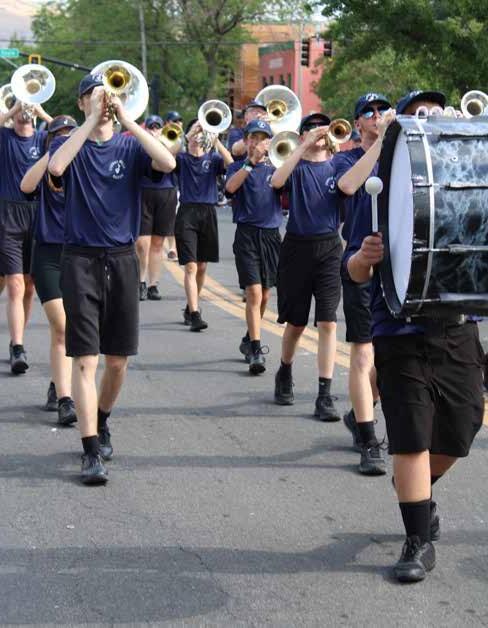




partment’s musical production of “Brigadoon” in November.
As they have for the past two years, Jazz Band students will solicit permission from ‘some of the big names in the pop funk genre,’ to compose their own arrangements of their songs which they will showcase at a completely student-produced spring concert.
“We go big—I’m talking fog machines, confetti cannons, lights, the whole shebang,” Kuhlemeier said. “It’s really cool treating our students like pros in that regard and giving them some further insight in the music world.”
Kuhlemeier has lots of ideas and utilizes his network of contacts from the recording studio and talent management business he owns, as well as cold email pitches, to initiate unique projects for his students.
“Throwing ‘education’ in the subject line tends to grab some attention,” he said. Kuhlemeier introduces students to the
production side of the music industry with a comprehensive music production course he created. The class, which is the only one of its kind offered in Jordan School District, appeals to both musicians and technicians.
“The course offers the career benefits of being an audio and sound technician and the creative insight of being a composer,” Kuhlemeier said. “We all come out published SoundCloud rappers by the end of it. We have a lot of fun.”
Kuhlemeier frequently collaborates with other bands . He created an annual Bandstravaganza event, in which the local high school and middle school bands promote their programs and get elementary school students excited about registering for band classes.
The upcoming Oct. 16 concert will feature a few of CHHS’s band ensembles as well as the West Hills and Sunset Ridge Middle School bands and the West Jordan Community Band. l

High school students marched on stage and in the aisles of the AJR concert at Utah First Credit Union Amphitheatre on July 22. (Photo courtesy Shannon Perry )
Courageous heroes honored
While teenagers are often criticized for being impulsive, three local teens were celebrated for their rash decision to run into a burning building.
By Jet Burnham j.burnham@mycityjournals.com
Best friends Cammerin Inselsberger, Carter Jacobson and Gabriel Hernandez were recognized by their school and community for their heroic act of rescuing two dogs from a house fire.
They were the first to arrive at the smoking house just down the street from where they were doing yardwork.
“We banged on the door and rang the doorbell and nobody answered,” Gabriel said. “And then Carter said, ‘There’s dogs in there.’”
Cammerin said he doesn’t remember much of what he was thinking during the rescue but at that moment he recalls thinking, “We have a job to do, we’ve got to get in there and save anything that is saveable.”
Propane tanks were exploding and the fire was spreading to other homes and their adrenaline kicked in. The boys kicked down the front door and ran through the house to see if anyone was there. They grabbed the frightened dogs and got them outside as the fire spread further and faster into the house.
Gabriel said he didn’t really think about the danger until later, when he realized some of his hair had been singed. “I don’t regret being in there, I regret not being as careful as I should have been,” he said.
His mom, Gabriela Aguillon, said her first response was to scold her son because of her concern for his safety.
But she was also very proud and glad to know her 17-yearold lives by the values she has taught him even when she’s not around.
“It was that moment when you realize your child is growing up and becoming the man he is going to be,” Aguillon said.
She’s grateful for the family, friends and community that have had a positive influence on him.
Heidi Jacobson, Carter’s mom, said her son always wants to help people.
“I said ‘No more running into burning houses!’ but they would do that again in a heartbeat,” she said.
The young men were honored several weeks after the fire when school and city officials paid them a surprise visit at their school, Copper Hills High School. They were applauded by West Jordan firefighters, police officers, city council members, representatives from Jordan School District and Copper Hills High School faculty and students.
The humble heroes received pins and tokens of recognition and appreciation for their efforts from Copper Hills High School Principal Rae Garrison, the SBO president, Jordan Education Foundation Director Mike Haynes and West Jordan Mayor Dirk Burton.
Jordan School District Safety Director Matt Alvernaz, in the “Honor of Excellence” tradition of the military and law enforcement, gave each young man a special ‘challenge coin.’
“A challenge coin is something that is given as a token of appreciation and respect for those who go above and beyond the regular everyday expectations of society,” Alvernaz said. He said it is a rare honor; in the time he has worked at the school district, he has only ever awarded one other challenge coin to a student.
West Jordan fire fighters and police officers congratulated the boys on their quick thinking response in the face of danger. Fire Chief Derek Maxfield said they had provided vital information for the fire department’s investigation. As first on the scene, they were able to give details about where the fire started.
As the Gonzales family deals with the aftermath of the fire that destroyed their home and belongings, they expressed relief that they didn’t also lose their dogs, Rocky and Simba, because of the boys’ heroic rescue.
“We are so eternally grateful to them because our family is whole,” Zera Gonzales said. l
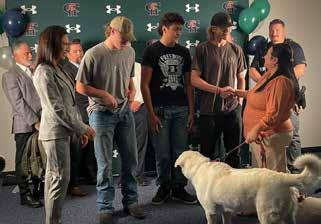
Ryan Davis Helps Protect What Matters Most
When it comes to insurance, Ryan Davis wants to protect the community and clients he serves. Davis is a locally based Allstate agent dedicated to helping people choose the right coverage and nd the products they need to weather any storm.
Davis & Davis Insurance, located at 7478 S. Campus View Dr., Ste. 102 in West Jordan, has a number one rated claim service on auto insurance for its customers and Davis brings that same passion to every product he sells.
“Insurance doesn’t mean much until you need it,” he said. “It’s gratifying to give people really good pricing, but also to make sure that they’re properly covered. To be able to work with a national brand, a reputable company that also o ers phenomenal pricing, has been pretty awesome.”
His team of experienced professionals builds lasting relationships with clients, giving them personalized attention and tailoring solutions for each situation. Insurance choices can be overwhelming, but Davis ensures his clients are getting the policies they need to t their lifestyle and budget.
Not only does Davis & Davis help with home, car and life insurance, but it also o ers policies that cover businesses, motorcycles, boats, ATVs, renters, pets and more.
Davis knows insuring a teen driver is expensive. Allstate helps young drivers improve their driving skills by providing interactive feedback. “Oftentimes, parents are very frustrated because their kids get in an
accident, but they get immediate accident forgiveness and they get the best pricing on the planet,” Davis said. “Our customers are normal. They make mistakes, they have tickets and accidents. We rarely say no.”
Renters can especially bene t from insurance and Davis said it’s usually cheaper to purchase a renter/auto policy than just an auto policy alone. The inexpensive renter policy covers a client’s possessions anywhere in the world.
At Davis & Davis, its mission is simple: nd insurance that ts a customer’s speci c needs.
Those interested can call 801-280-7115 for a FREE quote.
Davis and his wife, Melissa, are committed to community building. His o ce sponsors several events throughout the year, including movie nights, pumpkin patch and corn maze activities, and a meetand-greet with Santa Claus and his reindeer. Davis & Davis also supports the local women’s shelter.
The West Jordan resident earned a degree from Brigham Young University and an MBA from Western Governors University. Davis loves playing basketball, trying new foods and spending time with his wife and their four children. He also loves nding the best insurance for anyone who walks through the door.
“We have the best close rate in the state, and we’ve had that for ve years, because we know what we have, and we’re not afraid to share that with our customers,” Davis said. “Our customers don’t just pay for insurance, they pay for peace of mind, and they get a lot back in return.”



The Gonzales family thanks Carter Jacobson, Gabriel Hernandez and Cammerin Inselsberger who saved their dogs Rocky and Simba from a house fire. (Photo courtesy Jordan School District)
2025 GENERAL ELECTION VOTER GUIDE
WEST JORDAN VOTING INFORMATION SALT LAKE COUNTY VOTING INFORMATION
In West Jordan, six candidates are running for three At-Large positions:
Kayleen Whitelock, Annette Harris, Jessica Wignall Rob Bennett, Chris McConnehey and Sergio Sotelo are all of the city’s candidates.
In West Jordan, voters are encouraged to pay attention to important calendar dates (like mail-in deadlines) and voting locations.
For voters planning to vote-by-mail, ballots must be received by 8p.m. on election day (postmarks don’t count). In other words -- mail early.
“We had 110 ballots that were returned after the postmark deadline,” said City of West Jordan City Recorder Tangee Sloan. “I think it’s important for the residents to know that ballots must be received by 8:00 PM on Election Day, regardless of postmark.”
This is a change from previous election cycles when residents were able to postmark their ballots on the day of the general election. Per the recently passed H.B. 300, voters do need to make sure their ballots are physically ‘in-hand’ at at the Salt Lake County office (downtown Salt Lake) building on election day.
For voters who would like to drop off their ballot instead of mailing it in: West Jordan’s ballot drop boxes are located at City Hall (3600 Constitution Blvd.) and Ron Wood Park (6000 New Bingham Hwy.).

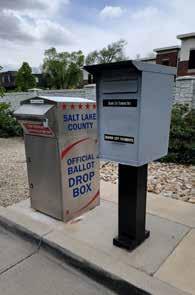
Hey Voters! Please review the following voting information directly from Salt Lake County before submitting your ballot.
Nov. 4 is the General Election - Vote Centers and drop boxes will close promptly at 8:00 p.m.
Important Dates
Oct. 10 - Salt Lake County will host Logic & Accuracy Tests where the public is invited to attend live demonstrations of voting equipment.
Oct. 14 - Ballots being to be mailed (21 days before the election as per Utah’s legislation).
Nov. 18 - Board of Canvassers Meeting where each city will certify results after presented to the City Recorders.
Vote Box locations:
Residents can vote by mail or in-person at various drop box locations throughout Salt Lake County:
County - Salt Lake County Government Center (2001 State St.)
Cottonwood Heights - City Hall (2277 Bengal Blvd.)
Draper - City Hall (1020 Pioneer Rd.)
Holladay - City Hall (4280 S. 2300 E.)
Herriman - City Hall (5355 Main St.)
Midvale - City Hall (7505 Holden St.)
Millcreek - Common (1354 E. Chambers Ave.)
Murray - Post Office (5025 State St.)
Sandy - City Hall (1000 Centennial Pkwy.)
Sandy - Senior Center (9310 S 1300 E)
South Jordan - City Hall (1600 W Towne Center Dr.)
South Salt Lake - Granite Library (331 S. 500 E.)
Riverton - City Hall (12830 S Redwood Rd.)
Taylorsville - City Hall (2600 W Taylorsville Blvd.)
Wet Jordan - City Hall (8000 S Redwood Rd.)

Voter Registration website
West Jordan - Ron Wood Park (6000 W New Bingham Hwy.)
West Valley - City Hall (3600 S Constitution Blvd.)
Register to Vote:
Residents can register to vote online up to 11 calendar days before the election (before 5pm). Registration must be submitted and received before Tuesday, Oct. 28 to receive a ballot in the mail. A valid form of ID, accurate address information, and date of birth is required to register. Residents can register either: online by visiting the State of Utah’s website (see adjacent QR code); through mail by filling out the Formulario de Inscripcion por Correspondencia Para Votantes (Voter Mail-In Registration Form) found on the County’s website; or in-person at the 2001 S. State St. office. Same-Day registration options will also be available at vote centers. Learn more about voting information through Salt Lake County’s website at: saltlakecounty.gov/clerk/elections. Or by directly emailing: vote@saltlakecounty.gov.
QUESTIONS
Sourced directly from our readers
One main reason/goal for why you are running for this election:
Do you believe current property tax revenue is being used effectively? How so?
WEST JORDAN AT-LARGE

To serve the residents of West Jordan and be their voice on the council.
Overall in West Jordan the taxes collected are being used efficiently. We prioritize public safety and public services. Some items I would not include as ongoing budget items, but use one time money for them are Christmas lighting and funds for celebrations such as opening a new bridge. Recently the council voted for an increase in compensation which I voted against as I feel this is a service not a job.

To keep West Jordan a great place to raise a family.
Yes. The FY 2025 budget reflects a prudent and effective use of property tax revenue, in my opinion.
*Balanced and sustainable revenue planning: Property tax comprises about 30% of the General Fund’s ongoing revenue—second only to sales tax—and the city forecasts a modest 3.5% increase to offset inflation while protecting services.
*Minimal impact on homeowners: That 3.5% adjustment amounts to roughly $14 annually for the average home—just $1.17 per month—generating $675,000 in new revenue to cover public safety costs, notably supporting 28% of those increases.
*Debt retirement that eases the burden: The budget completes the final payment on General Obligation Bond funded by property taxes. Once retired next fiscal year, that portion of the property tax will no longer be necessary - relieving future taxpayers.
In sum, property tax dollars are being allocated thoughtfully: funding essential public safety enhancements today while phasing out legacy debt-thus striiking a balance bbetween responsible spending and longterm fiscal relief for West Jordan residents.
Thinking about fiscal responsibility - what values should your local budget reflect? How do you plan to balance those values?
Our residents value public safety and keeping the community safe and well kept. I will continue to review the budget in depth and look for ways to improve our fiscal health by thinking outside the box to accomplish tasks.
What is your stance on local government cooperation with ICE?
ICE is a federal program and where required by law we need to cooperate. We should also not be afraid to set standards of operation in our community and stick to them. Currently my own thought is ICE is not operating as they should and we are seeing this play out in courts which is how our democracy works best by the three branches of government balancing each other. We need to reform our immigration laws and then follow them. Immigrants built America and we are better together. When we don’t follow law we have chaos and that benefits no one.
The budget should reflect prudence, prioritization, and preparedness. I approach city finances as I would my own family budget: cut unnecessary costs, invest in core services, and build reserves to weather uncertainty. By rooting decisions in those values, we balance careful spending with targeted investment.
West Jordan deserves community trust in government. Therefore, I would oppose city-level cooperation with ICE that undermines that trust—especially when it chills community engagement or disproportionately targets families. Local government should focus on public safety and community well-being—not federal immigration enforcement.
What are your highest priorities in regards to community safety, education, and resources?
Safety is a high priority and since being on the council we have increased both police and fire personnel. I have and will continue to request data to help us plan for the future. We recently acquired property for an additional police and fire station on the far west side as this area is growing at a rapid pace. We are also prioritizing equipment to keep our police and fire staff healthy and equipped with what they need. I was instrumental in bringing a second pair of turn outs for our firefighters which has shown to decrease cancer rates. As for education, that is a separate elected body, in our community I will support emergency preparedness classes for residents such as CPR and babysitting training. I will partner with entities that serve the community such as South Valley Services and the library.
Community safety: Maintain well-funded, community-focused policing and emergency response, with emphasis on proactive and preventive strategies.
Education: Strengthen partnerships with local schools, support after-school and youth programs, and ensure that our children and families have access to quality learning opportunities.
Resources: Advocate for parks, recreation, mental health support, and essential social services that build a resilient and thriving community
QUESTIONS
One main reason/goal for why you are running for this election:
Do you believe current property tax revenue is being used effectively? How so?
WEST JORDAN AT-LARGE
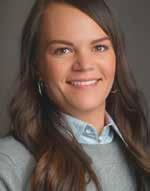
To ensure smart, transparent growth that protects our neighborhoods, strengthens public safety, and keeps West Jordan a great place to live for every generation.
Yes, I believe West Jordan is making strides in using property tax revenue effectively, but there’s always room for improvement. The city’s budget reflects investments in essential services like water infrastructure, public safety, and road maintenance and expansion to accommodate a growing population. These are long term investments that support growth and sustainability. However, I would advocate for clearer communication with residents about how their tax dollars are spent and ensure that every dollar aligns with community priorities.

The decisions made in the next 4-8 years will dictate the direction of West Jordan for the next 40-50 years. We can’t leave this to chance. We must have proven decision making on the council as well as fresh ideas or risk going backward.
The State Legislature has mandated how taxing entities must function to provide accountability and get feedback from those affected. When those rules are followed, a group of citizens (that we have designated the City Council) get together to hash out what is appropriate, what may be extra, and what may be missing in the Mayor’s proposed annual budget (he is responsible every year for bringing a budget to the City Council. The City Council does not set the budget - it can only approve, make changes, or deny the budget that is presented to them. It is up to the Mayor’s office to follow it or not.) If they operate in their responsibilities properly - and receive and listen to feedback from the citizens - then the budget funds are used effectively. Is there room for improvement? Are there changes that should be made? Almost certainly YES! But the process helps us decide what those changes need to be and after the changes, the budget that is left is approved for the next fiscal year. This process works when the participants fulfill their roles properly.
Thinking about fiscal responsibility - what values should your local budget reflect? How do you plan to balance those values?
Our budget should reflect transparency, equity, sustainability, and public safety. That means prioritizing:
*Infrastructure that supports growth and resilience
*Public safety funding that ensures our police and fire departments are well-equipped
*Community services like parks, libraries, and senior programs
*Economic development that attracts businesses and jobs.
To balance these values, I would support performance-based budgeting and regular audits. I’d also push for citizen-friendly reports and open communication to ensure residents have a voice in how funds are allocated.
Fiscal responsibility is a core value that must be retained by those who lead us. Tax money is sacred money that comes from the elderly, widows, single parents, people down on their luck, as well as everyday citizens and business owners. These funds must be only used to benefit the lives of ALL the people and not just those who can afford to be heard. I believe that during budget time, town hall meetings need to be held in person around the city to get the proposed budget and how to address it - seen, considered, and feedback given to those responsible for making the decisions. These need to be weighed and brought together after the feedback is given to decide what will stand and what is optional. The budget process is the most important oneand that affects the most number of people directly - of anything the city council does. We need to elect those who have demonstrated that they will always put the needs of the people first and have the wisdom to make decisions for those things that we can’t predict right now. We must not leave this to chance.
What is your stance on local government cooperation with ICE?
I do not support blanket cooperation with ICE, especially when it leads to civil rights violations or undermines trust between law enforcement and immigrant communities. West Jordan should not participate in immigration sweeps or workplace raids, and any cooperation should be limited to individuals already in custody for serious criminal offenses.
I would ensure West Jordan maintains a community-first approach, prioritizing safety and dignity for all residents regardless of immigration status.
I believe that ICE fills a legal need to perform a service of government to keep the land and its law-abiding citizens safe. Having said that, I believe that ICE and all other government entities involved in law enforcement have Constitutional requirements to follow the provisions of that document whether a higher-up decides to follow them or not. We must be a land of law. We cannot dismiss the law just because it is inconvenient or “seems” wrong to us. Processes must be followed so all can be protected. When they are, we are some of the strongest people on earth. Any government entity must obey the stipulations of law and due process, and when they do, then I can support their efforts.
QUESTIONS
Sourced directly from our readers
One main reason/goal for why you are running for this election:
Do you believe current property tax revenue is being used effectively? How so?
WEST JORDAN AT-LARGE

I’m running because I care deeply about West Jordan and want to keep our city on the right path. This is where I grew up, where Noni and I are raising our family, and where I’ve worked alongside neighbors for years to make our community better.
Yes, our property tax funds are used effectively. Looking solely at property tax, it’s worth noting that what West Jordan collects would barely cover the fire department, so we work hard to find additional revenue to fund everything else residents expect, such as police, courts, snow plows, parks, and more. That’s why the city has focused on economic development and sales tax growth, so we can strengthen essential services without overburdening homeowners…. We’ve even been able to include projects that while not strictly essential, make life better - like upgraded street lighting and improved playgrounds.
At the same time, we’ve delivered where it matters. During my time on the council we added 24 police officers, 8 firefighters, built Fire Station 54, maintained nearly 80 crossing guards, and added 63 acres of parks. And by pursuing creative ideas like opening a passport office at City Hall, we turned mandated passport fees into a local benefit, keeping over $215,000 here in West Jordan to fund services without raising taxes.

City Journals Note - As of our press date, Sergio Sotelo had not responded to our editorial staff’s inquiries. The following information can be found on his website:
“I’m running for City Council because I believe in people-powered leadership. My priorities are shaped by the voices of my neighbors — not party politics. From affordable housing to supporting local businesses to making our city safer and cleaner, I’m committed to showing up, listening, and taking action.”
“Our city is growing, but our infrastructure isn’t keeping up. I’ll push for strategic traffic solutions, improved access to public transportation, and better roadways to keep our city moving.”
“Too many families in our city are being priced out. I’ll fight to expand access to affordable housing options that meet the needs of working families and future generations.”
Thinking about fiscal responsibility - what values should your local budget reflect? How do you plan to balance those values?
Our city budget should reflect the core values of our community. For me, that means focusing on stewardship, safety, quality of life, fairness, and innovation. Balancing those values requires putting essentials first, maintaining discipline in spending, and being creative enough to still invest in the things that give West Jordan its character. Stewardship… Safety… Quality of Life… Growth and Innovation… Fiscal Responsibility & Fairness – funding essentials first and leveraging outside resources whenever possible through grants, partnerships, and regional cooperation. It also means recognizing that many other government entities (counties, schools, libraries, and more) are drawing from residents’ wallets, so every tax dollar collected by the city must deliver a clear and visible benefit.
“Our neighborhoods deserve clean, safe, and accessible green spaces. I’ll advocate for the development and improvement of parks and recreational areas so families have places to gather, play, and enjoy the outdoors.”
“Growing up in a hardworking Mexican American family, I learned early on that leadership means showing up, listening, and working together to build a better future. My wife runs a small business here, and like many of you, we’re raising our kids right here in West Jordan — juggling work, school, and family life with love and determination.
What is your stance on local government cooperation with ICE?
What are your highest priorities in regards to community safety, education, and resources?
If the law requires our cooperation with federal agencies, I will support doing what is legally required. But I don’t believe West Jordan should volunteer local resources for responsibilities that fall outside our jurisdiction. Our budget is already stretched to provide the essential services residents depend on every day, and we need to stay focused on those commitments. I was elected to serve the city, not to take on federal responsibilities, and that will remain my priority.
The highest priority is balancing the resources we have (primarily tax dollars) to meet the needs of our community. For me that begins with safety: maintaining reliable infrastructure like water systems, storm drains, streets, lighting, and school crossings, along with ensuring our first responders are trained and equipped to serve.
Education is directed by the school district, but the city can partner to support it through safe walking routes, providing crossing guards, well-maintained parks, and recreation programs that give students positive opportunities outside the classroom.
I’m running for City Council because I know our city deserves leaders who put people first, not politics. I want to bring honesty, accessibility, and real solutions to the challenges our neighborhoods face — from affordable housing and safer streets to better parks and public spaces.
Together, we can build a West Jordan where everyone has a seat at the table. I’m ready to listen, learn, and serve — will you join me?
Let’s make this community stronger — together.”
For more candidate responses check out our website at valleyjournals.com
West Jordan football off to good start in league play
The West Jordan football team won its first two Region 4 games, putting the Jaguars at the top of the eightteam league.
By Josh McFadden
As the 2025 prep football season got underway, the West Jordan Jaguars had big expectations.
After a tough start to the year, the Jaguars have hit their stride.
West Jordan went 1-2 in non-league play, falling 38-14 to Riverton on Aug. 14 and 30-0 to Alta on Aug. 29. However, West Jordan defeated its rival, Copper Hills, on Aug. 22 by the score of 29-27 and then won its first two Region 4 contests, both in lopsided fashion.
“Our team has set some lofty goals: win the battle of West Jordan with Copper Hills, win our region, have two playoff games at home and get to the U of U [for the Class 5A state semifinals],” head coach Ronald Halbert said. “We are very excited this year. Our team and coaches have put a lot of work in.”
Heading into the season, Halbert said the players lifted weights four days a week and “had a great padded camp.” He said the team also avoided injuries in preseason camp and entered the season healthy and hungry.
The goal of reaching the state semifinals may seem ambitious, but Halbert believes he has the players to accomplish it. The state semifinals and finals will be held at University of
Utah’s Rice-Eccles Stadium, which is 12 miles away from West Jordan High School. The motto “12 miles” rings through the Jaguars’ program as a reminder of where the team wants to be.
Halbert knows that getting there won’t be easy and won’t come without dedication, focus, resilience and playing as a team.
“In order to achieve our goals, we need to keep working hard, believe in each other, stay healthy and be focused on the 12 miles,” he said.
West Jordan has been dominant since Region 4 action kicked off.
The Jaguars had little trouble in any of these matchups, beginning with a 45-6 blowout of Taylorsville on Sept. 5. West Jordan was up 21-3 at halftime and 31-3 after three quarters. A pair of fourth-quarter touchdowns lengthened the deficit. Cody Johnson rushed for 74 yards and had 47 more yards receiving. Jayden Giles hauled in a 78-yard touchdown pass from Tyson Demke.
A week later, West Jordan took down Cyprus 38-7, not giving up any points after the first quarter. The Jaguars scored 24 points in the second quarter alone. Two scores came courtesy of quarterback Ayden Dunn, who threw touchdown passes of 80 and 30 yards to Porter Creasy.
Region play has showcased West Jordan’s biggest asset: speed.
“I believe our strength is team speed,” Halbert said. “We also have come together as a team and are working on the 12 Miles. We need to stay healthy and keep believing.”
Challenges lie ahead of the Jaguars.
Following its win over Cyprus, West Jordan had five games remaining, including what could be a first-place showdown at West on Oct. 3. On Oct. 17, the Jaguars host Granger to wrap up the regular season. The state tournament starts the following week.
Halbert said the players have positive attitudes and love to compete. He has no reason to believe the Jaguars won’t continue its hot play in region games.
“These young men every day work each other out on the practice field,” he said. “We sometimes have to reign them in. They love to hit and get after it.”
Numerous players have caught Halbert’s attention this season.
Halbert said Dunn, a senior, has been a “great leader.” He has impressed with his throwing ability and speed. Creasy is a threeyear starter and a first-team All-Region performer a year ago. The senior is another speedy component in the offense. Creasy had five catches for 66 yards and two touchdowns heading into the Cyprus game.
Running backs Cody Johnson, a senior, and Scooby Tulau, a sophomore, have been key contributors. Johnson, a shifty back who also plays safety, was a first-team All-Region player in 2024. Tulau was injured as a freshman but, according to Halbert, “would have started all season.” Johnson had 37 carries for 262 yards and two touchdowns in the first four games. Tulau has made a mark on defense, totaling 62 tackles, a sack and an interception in the first
four games.
Wide receiver Julian Valenzuela had 10 catches for 197 yards and a score in the first four contests. Anthony Fale, a senior, was an All-Region wide receiver last season and was also Honorable Mention All-State. Giles had made his presence known this season too on the offensive side of the ball. Other wide receivers to keep any eye on are Briggs Jones and Boston Dean.
“[Valenzuela] has great hands and works every day to improve,” Halbert said. “[Jones] worked hard in the offseason, [Dean] could be amazing.”
Linemen Paula Havea, Mason Tavita, Matt Boone, Ami Toutai and Porter Jones are tough, hardworking players. Some of these players regularly see action on both sides fo the ball.
Briggs Jones has been solid at safety and also plays wide receiver. Daryen Misionare is someone Halbert calls a “great cover guy” and who has “worked hard in the classroom and weightroom. Halbert also likes LA Moala and Anthony Fale. Bishop Lolohea, a second-team All-Region lineman in 2024 does a good job of protecting the quarterback’s blind side. It also helps to have a solid placekicker, and the Jaguars have that in Aaron Hunt, a first-team All-Region competitor last season.
“[Hunt] can be a game changer with his field goal capabilities,” Halbert said.
The Jaguars won Region 4 last season, going 5-0. The team has won eight consecutive league games. l






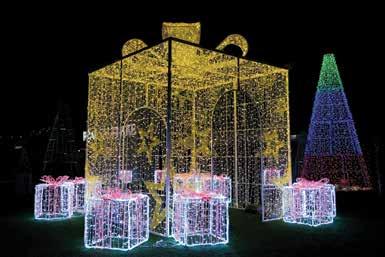
From costumes to candy: the safety checklist every family needs
Halloween Safety 101: The Essential Guide for Parents and Homeowners.
By Holly Curby hello@hollycurby.com
With Halloween right around the corner, families are busy planning costumes, buying candy and decorating their homes. But amidst the excitement, safety should be a top priority. This festive night—meant for costumes and candy—can quickly take a dangerous turn if precautions aren’t taken. According to safety experts Judy Chavez from the U.S. Consumer Product Safety Commission and Amy Bryant, Crime Prevention Specialist with Sandy City Police, Halloween is one of the riskiest nights of the year for children and families.
Here’s how you can enjoy the frightful fun without real scares.
Costume Safety: Keep it Fun and Flame-Free
“Costumes should fit properly—not too long, loose or baggy,” Chavez said. “Long, flowing fabric can lead to trips and falls or even become a fire hazard if it brushes up against open flames like in Jack-o’-lanterns.”
When choosing costumes:
• Opt for flame-resistant materials like polyester or nylon.
• Avoid sheer cotton or rayon, which are more flammable.
• Add reflective tape or glow sticks to ensure visibility at night.
• Use hypoallergenic makeup and remem-
ber to remove it before bedtime—especially for kids with sensitive skin.
Chavez added, “Costume safety isn’t just about fire. It’s about preventing falls, rashes and other injuries we see every Halloween.”
Home Security: Don’t Let the Wrong Goblin In
Bryant reminds homeowners that Halloween isn’t just busy for trick-or-treaters— criminals may be lurking, too. “Keep all doors and windows locked, whether you’re home or not,” Bryant said. “Don’t assume because it’s a family night that everyone has good intentions.”
Other tips:
• Don’t open the door to strangers if you’re not expecting them.
• Teach kids not to answer the door without an adult’s permission.
• Install deadbolt locks with a 1.5-inch throw for added security.
• Use long screws in strike plates for stronger resistance to forced entry.
And don’t forget the garage. “Garage doors left open are an open invitation,” Bryant said. “Close and lock them—and if you’re going out of town, unplug the garage opener entirely.”
Porch Pirates Beware: Protect Your Packages
Halloween kicks off the holiday season, which often includes more online shopping and deliveries. “Track your packages and get them off the porch as soon as they arrive,” Bryant said. “Porch pirates are waiting for a
chance to snatch them.”
Consider having packages delivered:
• To your workplace
• To a trusted neighbor
• To a secure community locker
Also, let trusted neighbors know if you’ll be out of town. “They can keep an eye on things, collect packages, and even roll out your trash bins to make it look like you’re home,” she added.
Trick-or-Treating: Safety on the Streets Trick-or-treating is a highlight of Halloween—but it also poses risks, especially after dark.
Bryant emphasized: “An adult should always accompany children. Even if they think they’re old enough, parents need to be nearby.” According to Chavez, the CPSC estimates 3,600 Halloween-related injuries occurred in recent years, many due to falls, allergic reactions and decoration-related accidents.
To stay safe:
• Use sidewalks and crosswalks—never jaywalk.
• Make eye contact with drivers before crossing.
• Equip costumes with flashlights, glow sticks or reflective gear.
• Choose well-lit neighborhoods and avoid poorly lit areas.
“Motorists, too, need to do their part,” Bryant said. “Drive slowly, keep headlights on, and be extra cautious in residential areas.”
Don’t Let Decorations Become a Disaster
That adorable Jack-o’-lantern on your

porch? It might be a fire risk.
“If you use candles, never leave them unattended,” Chavez said. “Better yet, opt for battery-operated LED candles.”
Also:
• Bring in pumpkins and outdoor décor at the end of the night.
• Avoid leaving anything out that can be vandalized or used dangerously.
• Monitor any electrical decorations for exposed wires or overloading outlets.
Have Fun, Stay Safe
Halloween is meant to be fun—not hazardous. With the right precautions, families can enjoy the thrills of the season without becoming part of the injury statistics. As Chavez puts it, “It’s about making smart choices. We want Halloween to be memorable for the right reasons.” l

Pirate costumes prepped for a safe night of trickor-treating (Photo credit: Jim Harding)
Halloween comes to class—with rules
Spooky season is approaching and for elementary schools that means combining costumes, classwork and community with safety.
By Julie Slama j.slama@mycityjournals.com
As about 600 Glacier Hills elementary students parade through a White City neighborhood in costume on Halloween morning, safety remains top of mind for Principal Julie Winfree.
“We will have police officers lead, follow and patrol intersections and we’ll have teachers, aides and extra staff with walkie-talkies walking with the students,” she said, urging parents to ensure kids wear appropriate shoes and coats. “It’s a fun opportunity for the parents and community to sit out on their driveways and see the students parade by; they line the streets.”
Still, she notes, “It’s also a day of learning so we want students to wear costumes they can learn in.”
That means no masks, weapons or facsimiles of weapons—guidelines shared across most Salt Lake Valley schools.
Luke Allen, Granite School District’s associate director of communications, said costumes must follow regular dress code rules.
Those guidelines include students must be fully dressed, with clothing that covers the body appropriately and includes safe footwear. Students also may not cover their face unless it is for religious, health or medical reasons. Costumes or clothing may not display images, symbols or language that depict obscenity, lewdness, hate, violence, drugs, alcohol, tobacco or gang-related activity, and they may not include items that could be used as a weapon. Student attire and expression also must not cause significant disruption to learning.
“Halloween can be a fun opportunity for students to celebrate together, but we remind families that costumes at school
must follow the same rules as everyday attire,” he said. “Our focus is always on ensuring a safe, respectful and positive environment for all students.”
Many of Granite District’s 26,000 elementary students participate in Halloween parades, typically held outdoors, weather permitting.
Canyons School District Risk Manager Ryan Jakeman advises parents to consider different costumes for school and trickor-treating.
“Masks, which block visibility, and facsimiles of weapons are a ‘no-go’ at school,” he said, recommending face paint instead. “While costumes are encouraged, safety is also a priority for students.”
Canyons spokesperson Kirsten Stewart adds: “We’ve found outdoor parades, provided you can identify a safe route, are a great way to involve the community.”
Jordan School District also has shifted most parades outdoors post-COVID.
Jordan District’s Director of Communications Sandy Riesgraf said schools typically remind families: “no masks, weapons or excessive face paint. The school staff needs to be able to identify students.”
Riesgraf added costumes should be wearable all day and follow district dress codes.
At Falcon Ridge Elementary in West Jordan, Principal Aaron Ichimura said dressing up helps build connections between students and administration.
“They get to learn we’re human and enjoy doing the same things they enjoy,” he said. “Halloween traditions are deeply rooted in Utah.”
The school holds a PTA-run festival with students rotating every 30 minutes with seasonal grade-level activities.
“We’ll send out a Parent Square message reminding students not to wear masks, because we want to be able to identify students, no weapons or facsimile of weapons, no blood or vio-


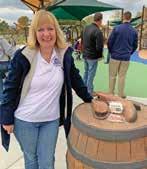
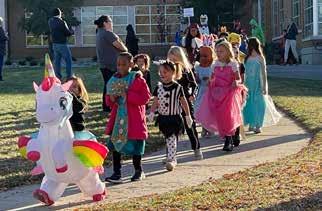
lent costumes,” Ichimura said. “We want Halloween to be a fun time for everyone.”
Like other principals, Ichimura emphasized classroom learning.
“We encourage staff to plan learning activities, and they can be ideas linked to Halloween like stories or math so it can be a creative, fun approach to learning,” he said.
In Murray School District, individual schools set safety guidelines.
“Halloween is a fun and exciting time for our students, and we support school administrators in creating a positive and safe environment by developing traditions and practices unique to their school,” said Doug Perry, Murray District’s communication officer. “We also encourage families and the community to prioritize safety when choosing how to celebrate, both at school and beyond.” l







Halloween parades, like this one at Sandy Elementary in 2023, are fun for students and the community, but safety is an important factor, principals say. (Julie Slama/City Journals)
Preparedness conference readies community members for emergencies
By Peri Kinder peri.k@thecityjournals.com
No one wants to face an emergency, but being prepared can mean the difference between safety and chaos. At the first Fall Preparedness Conference on Saturday, Oct. 25, Utah residents can learn how to prepare for earthquakes, wildfires, floods, power outages and medical emergencies at the South Salt Lake Community Center (2531 S. 400 East).
The free event is open to all community members, bringing together resources, agencies, experts and demonstrations to help families, groups or individuals build skills, acquire confidence and learn how to prepare for the unexpected. Emergency preparedness experts have stated that a communication plan, basic skills and an adequate supply of food and water can save lives during dangerous situations.
Held in conjunction with SSL, Salt Lake City, Millcreek, Holladay, Murray and Cottonwood Heights, the Fall Preparedness Conference is about building resilience and knowledge.
May 23rd
Golden Corral, 665 East 7200 South, Midvale
“We want to make sure people are hearing about this and feel welcome to join us,” said SSL Emergency Management Coordinator Yasmin Abbyad. “If people have



any questions, whether it’s about how they can be better prepared, how they can prepare their homes and what they should do in terms of insurance, we will be able to answer those questions.”
The morning event will feature breakout sessions that include Hands-on Stop the Bleed training; a CERT skills station to practice triage, cribbing, carrying and fire extinguisher use; a moulage demonstration to learn how to apply realistic, mock injuries; and the HAM It Up radio essentials course for understanding ham radio operations.
“We have a lot of people in our community who have gotten a ham radio license, but they don’t necessarily know how to use their radio, or don’t know how to get connected to the community,” Abbyad said. “We have five or six different groups that will be present at the conference, where people can ask questions to experts in the field.”
The afternoon is dedicated to a full disaster simulation where community members can practice skills they learned in the CERT course. People who haven’t earned a CERT certification can shadow the members or watch from the sidelines to learn necessary disaster actions.
For decades, Utah officials have encouraged residents to prepare for disaster. Abbyad mentioned the recent fire in Millcreek, caused by a lawn mower, that left 80 people without a home. She also pointed out the predicted
Dinner Seminar
Learn more about AdvancedFuneral Planning, Wills, Trusts, Burial Plots, and Cremation

earthquake in Utah, which could cause major damage and injuries.
“If the big earthquake hits us, it could take up to four days for outside resources to get to us. Highways might be down, electrical lines and trees are likely going to be in the streets and all of that has to be cleared before they can make their way to hospitals or extremely damaged areas,” Abbyad said.
“We want to make sure people are prepared with water and the ability to survive for four or five days without the amenities we’re used to having.”
Although the event is free, pre-registration is appreciated so organizers have an estimated number of attendees. Visit SSLC.gov or email yabbyad@sslc.gov for registration information. l




The Fall Preparedness Conference on Saturday, Oct. 25, will help groups, businesses, families and individuals get ready for an emergency. (Adobe stock)
Senior show demonstrates the art of aging brilliantly
The exhibit honored the beauty of experience and lifelong expression.
By Peri Kinder peri.k@thecityjournals.com
Abroken swing hangs from a tree branch, next to an empty house depicted in colors of brown and gray. The picture is titled “Where Have All the Children Gone?” and was painted in watercolor by Millcreek resident Ralph Morelli to depict the loneliness he felt when he didn’t visit with his children and grandchildren.
Morelli’s painting was one of more than 200 entries in the third annual Senior Art Show, sponsored by Salt Lake County Aging Services. Held at the Salt Lake County Government Center (2001 S. State St.), the display featured art in every medium, created by seniors aged 60 and up from around the county.
“Art allows us to express feelings that we might otherwise not be able to give verbally and that’s why I believe it’s so important,” Morelli said. “My art is called emotionalism, because I’m not going for realism. I can express myself with just a few brush strokes. That’s why I think art is important. It allows us to tap into that inner self.”
The show included displays of pottery, watercolor paintings, sculpture, needlework, quilts, oils and acrylic paintings, photogra-
phy and carvings. Many of the works were done at county senior center locations.
Afton January works with the county’s aging services program. She said the pop-up gallery is a fun way to bring exposure to artwork created by the state’s seniors and give them a chance to show off their talents. Last year’s event had fewer than 90 entries, but the 2025 show had more than double that number.
“It’s frankly a smashing success this year. The skill level is off the charts,” January said. “It’s one of those events that’s been gaining momentum, because it’s a fun opportunity for folks, especially our senior center participants, who represent most of the artists here, to take what they do at those centers and bring it into the community in a way that really feels intergenerational and community spirited. And it’s a fun opportunity for our older adults.”
Millcreek resident Eve Cole entered several artworks at the show, including a drop-pour painted vase and picture, and a framed arrangement of dried flowers. Cole said her sister-in-law got her interested in art during COVID, so they FaceTimed together while creating fun art pieces.
Her painting, “Black Bird in Flight,” was made with a drop-pour background, accented with black and white.
“I showed it to my husband and he said, ‘It’s birds flying.’ I never even would have

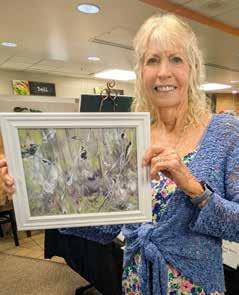
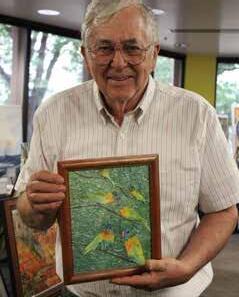
thought of that,” Cole said. “It’s just so rewarding. It just makes me happy.”
More than 300 visitors at the art show voted on their top three favorite entries. The Director’s Choice winner was Dewey Hansen (River’s Bend Senior Center) and the top three vote recipients were Deborah Chiquito (Riverton Senior Center), Shu Yamamoto (Taylorsville Senior Center) and Margi G Owens (Kearns Senior Center).


“Our older adults, many of whom are retired, get to showcase their work and feel like they’re a part of something big and public,” January said. “It gives them some recognition.” l
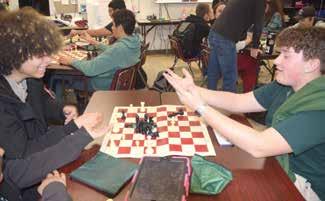

The Director’s Choice winner of the Salt Lake County Senior Art Show was Dewey Hansen, a regular attendee at the River’s Bend Senior Center in Salt Lake City. (Photo courtesy of SLCounty)
Eve Cole holds her art show entry, “Black Bird in Flight.” The Millcreek resident started painting during COVID. (Peri Kinder/City Journals)
Days for Girls provides the gift of opportunity
Volunteers craft menstrual care kits to help girls stay in school and live with dignity.
By Peri Kinder peri.k@thecityjournals.com
more than 500 million women and girls around the world, access to menstrual products is nonexistent. The term “period poverty” describes the struggle faced by people who don’t have adequate menstrual supplies and education.
Days for Girls is a global nonprofit offering dignity and health to women and girls by providing sustainable menstrual kits. Volunteers around the world sew, assemble and distribute the kits, allowing girls to stay in school, attend work and alleviate health concerns that arise when menstrual products are unavailable.
Suzanne Walker runs the Midvale chapter of Days for Girls, along with her friend Jennifer Woods and lots of volunteers. The chapter has created and distributed nearly 2,000 kits to Thailand, Mexico, Vietnam, Fiji, Morocco, Zimbabwe, Peru, Cambodia and Nepal.
“We not only sew components, we are also a source of outreach for our community,” Walker said. “We advocate on behalf of Days for Girls International, teaching about its mission and the reasons why there is a need for such an organization to exist. We also conduct



work events with local churches and business groups, in which they help create the kits that will then be distributed throughout the world.”
Days for Girls was started in 2008 by Celeste Mergens. She was working at a Kenyan orphanage and found that menstruating girls would sit on pieces of cardboard, often going without food. With cultural taboos around menstruation, some women and girls can’t attend school or work, or even go into a kitchen while on their period.
Mergens created washable, long-lasting pads and underwear, designed to last several years, giving the girls the freedom to leave their rooms, reclaim their dignity and potentially end the cycle of poverty.
“The evolution of this pattern for these kits has changed many times,” Woods said. “They keep making it better and better. They listen to the girls and the moms, and the feedback that people give, and they fix any issues.”
The kits contain two pairs of underwear, two reusable shields, eight absorbent liners, a washcloth and soap for cleaning, and a waterproof bag to hold everything. Colorful fabrics help normalize menstruation and the components dry quickly to allow the women and girls to manage their hygiene. The waterproof bags are also used as a washing device in places where water is scarce.
“Some girls and women walk miles and miles for water,” Woods said. “They have this very small amount of water to use for their


cooking and their cleaning, so these bags become little washing machines.”
Walker said it’s a lot of work to create the kits and they have specific instructions to follow to ensure the pieces work together. But she calls it a “labor of love” for the thousands of women and girls their kits have helped over the years. The group holds service projects several times a year, where volunteers sew kit components.
“Even in the United States, there are women who don’t have access to period prod-
ucts,” Walker said. “There are hundreds of stories of lives being changed through Days for Girls. I love going into my community and talking about it, because we don’t talk about it. I talk to a lot of young women’s groups and they are super embarrassed, but they have no idea how lucky they are.”
To learn about volunteering or donating to the Days for Girls Midvale chapter, visit the Facebook page @dfgmidvale. For information about the international organization, visit DaysForGirls.org. l









Millions of women and girls have received menstrual kits from Days for Girls. The Midvale chapter has created and distributed thousands of kits to girls all over the world. (Photo courtesy of Suzanne Walker)
The community gathers
Neighbors enjoyed an evening of connection by the river’s edge.
Peri Kinder peri.k@thecityjournals.com
Riverton residents flocked to the Jordan River at Dr. O. Roi Hardy Park to learn about wildlife, ecosystems, trails, wetlands and more. Held on Sept. 8, Riverton’s Jordan River Night was part of the Get to the River Festival organized by the Jordan River Commission and Jordan River Foundation.
The festival celebrates the 50-mile Jordan River Parkway, with each city located on the waterway hosting its own community event. Riverton City Councilmember Tawnee McCay serves on the JRC and said Riverton’s Jordan River Trail is a place to get away from the noise, enjoy a stroll and be out in nature.
“I love the Jordan River,” she said. “It used to be that residents couldn’t navigate it by boat or bike or on foot. I love that so many different organizations and groups got together to help make this available. Our family loves to come and ride bikes here.”
Attendees at the event were given an adventure passport with 13 stations to visit. Several organizations participated by hosting a station, sharing information and handing out fun prizes.
The Clark Planetarium educated residents about how light pollution affects migratory birds, Hogle Zoo was on hand to talk about the monarch butterfly way station located in Riverton and volunteers from city committees pointed
out significant points along the walkway.
Linda Abel, former chair of the Riverton City Historic Preservation Commission, talked about the historic Jordan River Bridge, first constructed in 1864 as a means of trade between Riverton, Draper, Sandy and Bluffdale.
“It was reconstructed in the early 1920s,” Abel said. “In 1981, it was deemed unsafe for vehicular traffic as they’d built the new bridge over on 12600 South.”
Riverton’s Jordan River Night also highlighted the city’s water, sewer and mosquito abatement systems, including the new Green Well that was activated earlier this year.
Ken Saldivar serves as the city’s water quality and conservation specialist. His booth focused on culinary water and conservation.
“Our Green Well is producing about 800,000 gallons of water every day,” he said. “Then we are also putting a little water in the river to send it to the Great Salt Lake.”
Trail etiquette was emphasized at one of the stations, as volunteers handed out bike bells to help keep trail bikers, runners and walkers safe. Kim Yore volunteers on the city’s parks and trails committee. She said trail etiquette includes keeping to the right, passing on the left, and using a bell or friendly voice to alert others.
“Our community has grown,” Yore said. “We have a lot of different users of the trails: bicycles, scooters, moms and dads pushing strollers, and people old and young who are walking. Our trails have become busier, especially when you add e-bikes.”
The first 200 people who completed the adventure passport at Riverton’s Jordan River Night received a free




River Trail
hot dog dinner. McCay hoped the event would encourage residents to get to the river more often to enjoy natural habitats and walkways.
“One of the top requests on our citizen survey is for more trails and paths, so we need to take advantage of the ones that we have,” McCay said. “I would like to have our canal trails paved, because we actually have five canals that run east to south.” l


Riverton’s Jordan River Night included a walk along the Jordan River Trail, where participants could visit educational sites to learn about the area. (Peri Kinder/City Journals)
Spooky geology: A look at the mysterious ideas about stone and the paranormal
The Rio Grande Depot has been the subject of numerous haunting stories, most famously the legend of the “Purple Lady.” The Stone Tape theory attempts to explain why some locations seem to be more haunted than others.
By Collette Hayes c.hayes@mycityjournals.com
Whatif a building could remember every moment, every story and every experience that’s happened within its walls?
The Denver and Rio Grande Western Depot, constructed in 1910 in Salt Lake City, is known as one of the most beautiful and haunted buildings in Utah. Its exterior features a 5-foot-high base made of rare Colorado Yule marble complemented by brick and terra cotta above the marble base as well as a red tile roof. The interior of the depot is adorned with elegant marble finishes sourced from Kansas City. The combination of brick and stone construction provides the perfect medium for residual hauntings, which are often explained by the Stone Tape Theory. This theory suggests certain materials can “record” events that occur around them, serving as a common explanation for ghost sightings and apparitions.
The pseudoscientific Stone Tape Theory suggests that traumatic events can leave an
imprint in stone, rock and brick. These materials are believed to be particularly effective at recording past events, which then can be “played back” like a recording. Limestone is considered the most effective of these materials. Marble, being a metamorphic rock derived from limestone, shares similar chemical properties, making it also highly effective in capturing past events. Sensitive individuals may be more attuned to the energy emanating from the stone in buildings, which could explain why only some people have experienced paranormal activity in the Rio Grande Depot.
The Stone Tape theory attempts to explain why certain locations seem to be more haunted than others, as well as why similar events tend to repeat in specific hauntings. It also provides insight into a common type of paranormal experience. Witnesses at the depot have reported seeing figures engaged in their daily activities, hearing disembodied sounds such as footsteps running down the hall, doors slamming, an emergency telephone ringing at 3 a.m., and lights turning on and off. Additionally, there have been sightings of a distressed woman dressed in purple in the second-floor ladies’ restroom, who has also been seen frequently near the café.
“While working in the Rio Grande offices, I never personally experienced anything out of the ordinary,” Deputy Director of the Utah Historical Society Kevin Fayles said in a recent conversation. “However, others have re-
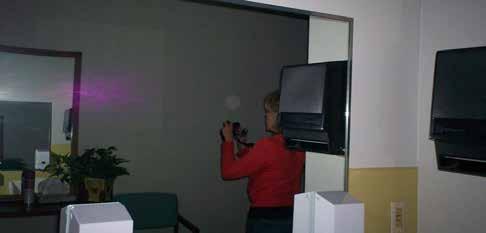
ported hearing the sound of running footsteps in the basement hallway. Also, I have an image of purple mist on the mirror in the ladies’ restroom, taken by a former employee. Another photo I have is looking down a hallway, where you see three faint figures. The building’s age could contribute to the feeling that it is haunted. I definitely wouldn’t want to be alone in the building at night.”
The Stone Tape Theory is compelling, but is backed by little scientific evidence. However, it does offer some explanation as to why individuals who have worked at the Rio Grande Depot have experienced similar events in the

exact same locations.
An employee told Fayles that the Purple Lady was the creation of a former historical society colleague who had worked there long before Fayles took a position with the society. Apparently, the woman who invented the story believed that every train station should have a legendary ghost story. So, she fabricated a tale about a raven-haired beauty dressed in a purple pillbox hat, dress and matching heels. The story goes that the woman died under a train while trying to retrieve her engagement ring, that had been thrown on the tracks by her angry lover.
As reported in local media, the building has been the subject of numerous investigations including ghost hunters, psychic mediums and a séance performed by a Wiccan. The investigative findings fell a bit short of explaining the strange occurrences experienced by several employees at the Rio Grande Café.
Cafe staff have reported unusual incidents, such as hearing a woman singing in the bathroom when the building was closed, experiencing flickering and turning off of lights, and receiving a 3 a.m. call from an emergency phone located in an empty elevator.
Also, Utah Department of Heritage & Arts Communication Director of Communications Josh Loftin noted that people have reported hearing footsteps on the upstairs balcony, sounds of talking or music playing, ghostly sightings upstairs and even alarms going off unexpectedly.
Paranormal historian Troy Taylor, author of more than 150 books on history, hauntings, true crime and host of the popular podcast “American Hauntings,” suggests that the vast majority of the paranormal cases he has been involved in have perfectly natural explanations. He says, “It is easy to feed off one another’s fears and literally ‘invent’ a haunted house.” Although he admits, “I have been involved in some cases that did puzzle me and left me feeling that the location really was haunted.” He says to keep in mind, “When investigating a paranormal event, activity rarely occurs during an investigation.”
Residual hauntings can attempt to explain most of the haunting activities that have been reported at the depot. Digging a little deeper, though, what about the water taps that turn on and refuse to turn off, reported by an employee
An image of purple mist on the mirror in the ladies’ restroom, taken by a former Utah Historical Society employee. (Photo courtesy Kevin Fayles)
or the Rio Grande Depot Café employee who said she was repeatedly locked out of the building late at night with no explanation, or cold spots in the building with no apparent cause for the low temperature? And the most pressing question: Will the new renovation of the depot stir up even more haunting activity?
Jeff Hymas, Utah Department of Government Operations executive communications director said, “For more than five years, extensive efforts have been undertaken at the Rio Grande Depot to assess the damage caused by a March 2020 earthquake, and to make the necessary repairs. As part of this process, the Utah Division of Facilities Construction and Management is working to ensure the restoration of the building’s structural integrity and to protect against future seismic activity. The building remains closed to the public while construction activities continue.”
According to paranormal belief, renovations in a haunted building can sometimes disturb spirits and lead to a significant increase in paranormal activity. While there is no scientific evidence to support this idea, many homeowners have shared ghost stories that describe this phenomenon. One common theory is that renovations can unsettle spirits that are attached to the building. The changes may feel like an invasion to an entity that considers the building its home, leading to the spirit becoming restless or agitated.
On January 7, 2021, Adrienne White, owner of House Genealogy, began renovating her newly purchased historic home in Sugar House. While working in the basement, White
NOW SELLING
and her sister encountered an inexplicable, almost paranormal, occurrence: an unidentifiable noise resonated through the house. Quickly returning upstairs, they found nothing out of place nor evidence of an intruder. The experience prompted her sister to search for information about White’s home, which led to the discovery of an obituary for a woman who had passed in the house on January 7, 1976— exactly 45 years from the day the renovation had begun.
“I’m not a nonbeliever in paranormal activity, but I don’t believe 100% either. However, my sister sending me the obituary changed my life,” White said. “It sparked my curiosity about the people and events that came before us, prompting me to explore the history of my home and other homes throughout the city. Amazed and fulfilled by what I uncovered about my home, I launched House Genealogy in February 2022.”
According to Jerod Johnson, a principal for the structural engineering firm Reavley Engineers, the Rio Grande Depot suffered severe damage from the 5.7 magnitude earthquake in 2020. Those involved in the renovation project have stated it could require “several years” to complete.
It may be quite some time before it is known whether the Rio Grande Depot experiences a significant increase in paranormal activity as a result of the current renovation. When the doors reopen to the Rio Grande Depot, the suspense surrounding this possibility will welcome both the curious and the brave to explore its intriguing hauntings further. l
















Local pet shelters address myths about black cats

Ruff Patch Rescue and Draper City Animal Services are just two examples of local animal welfare organizations that help find homes for pets and dispel negative myths about black cats.
By Katherine Weinstein k.weinstein@mycityjournals.com
Black cats experience lower adoption rates and higher euthanasia rates compared to other colored cats in animal shelters across the U.S. On a local level, however, things look a bit brighter for this symbol of Halloween. Ruff Patch Rescue and Draper City Animal Services are just two examples of area animal welfare organizations who work to find homes for all kinds of pets and help dispel negative myths about black cats.
“We actually get a lot of people who love black cats,” Jocelyn Callahan, a volunteer with Ruff Patch Rescue, said. “Kitties with more unique coloring, like Siamese and calicos, capture peoples’ eyes and often get adopted first. But black kitties aren’t always last. I think that once someone has a black cat and realizes how great they are, they want to adopt another.”
Anyone who has had the spooky experience of encountering a black cat in the dark, its eyes shining in the shadows, can appreciate how the animals became objects of superstition centuries ago. The notion that black cats bring bad luck is fading but is still one of the reasons why they have a harder time being adopted. Their dark fur also makes it more difficult for people to discern their features in shelters and it can be challenging to photograph black cats for adoption websites.
Officer A. Hurst at Draper City Animal Services acknowledged that black cats are often the last to be adopted. “But then there are people who are specifically looking for black cats,” she said, adding that all of her own pets are black.
A popular misconception about black cats is that animal welfare organizations usually suspend adoptions of the animals during the month of October out of concern that they will be harmed or discarded after Halloween. “That is a myth,” Hurst stated.
The ASPCA, the Humane Society of the United States and Best Friends Animal Society have issued statements in recent years declaring that there is no evidence that adopting black cats at Halloween poses a greater risk to the cats than adopting them at any other time of the year. Many













Jenny, a black cat adopted from a foster caregiver affiliated with Best Friends Animal Society, poses with a jack-o’-lantern. (Photo by David J. Weinstein)
shelters actually use Halloween to promote the adoption of black cats.
Hurst, who has worked in the field of animal welfare in Utah and Colorado for over 20 years, said, “At the shelters I’ve worked for, we promoted the adoption of black cats at Halloween.” She added that some shelters give black cats Halloween-themed names to help get them adopted.
Callahan explained that Ruff Patch Rescue has a thorough vetting process for prospective adopters to help ensure that all pets go to homes where they will be safe and well taken care of. “We do have a contract in place,” she said. “We make sure that people are adopting for a reason. The whole family has to be involved.”
On a global scale, increased awareness of the plight of black cats in shelters is making a difference in how many find their forever homes. National Black Cat Appreciation Day, on Aug. 17 in the U.S. and National Black Cat Day, on Oct. 27 in the U.K., were founded to honor the value of black cats and dispel superstitions.
Last spring, NPR reported that adoptions of black cats increased thanks to the 2024 Academy Award-winning animated film, “Flow,” about a black cat who bonds with other animals to survive in a flooded world. “Anytime there’s a movie with a specific breed, there’s an uptick in adoptions,” Hurst said.
There are many pet rescue organizations and animal shelters in the Salt Lake Valley filled with cats and dogs of all colors and breeds who are seeking homes. Ruff Patch Rescue, founded in Riverton, consists of a network of volunteers who foster all kinds of animals for adoption. They hold regular adoption events on Saturdays at the Riverton PetSmart. Visit ruffpatchrescue. com to see pictures of available pets.
Draper City Animal Services oversees a no-kill shelter. Lost pets without identifying tags or microchips are put up for adoption after a standard holding period of five business days. They are kept until they are adopted or eventually given to a pet rescue group. For more information, visit www. draperutah.gov/living-in-draper-city/animal-services/. l











Photo: Don Polo Photography
The Power of Human Connection in Salt Lake County
is in a paradox. We are known as one of the most social states in the nation, yet our residents also report some of the highest feelings of loneliness. State health surveys show that nearly one in four Utah teens in 2023 and about 6% of adults in 2021 said they often or always felt, “People are around me but not with me.” That’s a sobering reminder that being surrounded by people is not the same as feeling connected to them.
The U.S. Surgeon General defines loneliness as the distress of not having adequate meaningful connections, while social isolation is the objective lack of social roles, relationships or interaction. Both are harmful. Loneliness raises the risk of premature death by 26%, and social isolation by 29%. Utah data show youth are particularly vulnerable, with loneliness peaking around 10th grade. At the other end of life, older adults may report less loneliness, but many live alone or are less socially active, leaving them isolated—and at increased health risk— even if they say they feel fine.
It’s not all bad news. Among adults, reported loneliness has risen from 5% in

2019 to 16% in 2024. While that increase seems alarming, some experts believe it reflects growing awareness. More people are recognizing that connection matters, which may encourage them to seek help or create new relationships. Meanwhile, Utah’s highest years for suicides (2017) and overdose deaths (2022) are behind us, with rates trending slightly down. We should not ignore loneliness, but perhaps our awareness is a hopeful step toward stronger, healthier communities. Addressing loneliness requires all of us. Parents can set the stage at home by turning off screens, setting aside phones, listening closely, and modeling the conversations they hope their children will have with others. Simple family meals

and one-on-one time give youth safe spaces to share what they’re really experiencing.
Schools and businesses also play a role. Policies that encourage real connection—team projects, buddy systems, carpools, phone-free zones or mentoring programs—help students and employees build relationships that strengthen both well-being and performance. Identifying at-risk youth early and linking them with mentors can make a world of difference.
Local governments can create environments where connection naturally happens. Parks, libraries, recreation centers and public transportation all serve as “third spaces” where neighbors can meet. Programs like Salt Lake County’s Free Youth Rec Passes, summer events, farmers markets and free-fare zones lower barriers and invite people to gather. These aren’t just amenities; they are investments in the health and strength of our community.
Faith groups, sports teams and even traditions around food and gathering offer additional pathways. Whether it’s cheering together in the stands, sharing
a meal or volunteering at church, these experiences weave the fabric of community life. With creativity, we can support system-level changes that expand these opportunities in healthy ways.
In the end, the responsibility rests with each of us. Teens can choose to include someone sitting alone. Adults can prioritize friendships, check in on a neighbor or carve out time for family. Older adults can accept invitations or invite others into their routines. Each of these choices is small, but collectively they build the kind of community Salt Lake County is known for—caring, connected and resilient.
So I encourage you to pause and ask yourself: Am I truly connecting or just surrounded? Whether you are a student, a parent, a business leader or a retiree, you have the power to strengthen the web of relationships that hold us all together. In Salt Lake County, our greatest strength doesn’t come from policies or programs alone—it comes from people. When we choose connection, we choose health, hope and a brighter future for our community.






•















Life and Laughter - Magic is a Superpower
Back in the day, it didn’t take much to be labeled a witch. Did you own a cat? Witch. Did you have a birthmark? Witch. Did you use herbs, wear a cape, know how to read or lure children into your gingerbread-flavored home so you could eat them for dinner? Witch.
I’m just saying, the bar was low. Starting in the 1450s, witch hysteria swept across Europe, lasting for centuries. Intense warfare, hardship, famine and disease meant only one thing: it was time to burn the witches, because obviously.
Nearly 60,000 people were tried and killed as witches. More than 80% were women and 60% were over the age of 40. It was a gendercide that wiped out generations of women. Many were healers, midwives, widows and property owners.
They’d reached a time in their lives where they were fine being alone, with maybe a cat or two. They just wanted a nice broom, a boiling cauldron of soup and a Pinterest board of “Witchy Reads.”
Many women step into their power once they hit 40, but give women power and there’s going to be trouble. Killing the older generations meant wisdom was lost forever, which is probably why we have mini golf sets for the toilet.
Like Labubu and Meta (and just as

diabolical), witch trials were big business. Women were arrested, property was seized and people flocked to churches because no one wants to accidentally sell their soul to Beelzebub.
The witch trials also created a disconnection between women; a fear of gathering, the angst of being seen as a “coven” when all you wanted to do was watch the “Real Housewives of Salem.” Women stopped socializing because having a friend for tea could end in a hanging. (And you thought your book club was stressful.)
I’m a lover of all things witchy, a devotee of strong women using their magic for good. A witch is a woman who speaks truth to power, without shame. Imagine a combination of Dolly Parton, Oprah Winfrey and Ruth Bader Ginsburg, a woman so powerful even the Puritans would have been like, “Nope, not today.”
You see, a witch hunt creates a cul-
ture that undervalues women. When you describe women as shrill, chatty, feisty, mousey, sassy, emotional, slutty, hysterical, irrational or hormonal, those words strip away power.
How many of these words are used to describe men? Almost zero. At the worst, men get labeled as “grumpy,” and somehow that becomes “distinguished.”
There’s still a witch hunt going on today. Saying “women’s rights” to certain groups triggers frothing at the mouth and a call for the ducking stool.
Women want to be believed, heard and have the ability to live without violence or discrimination. We want affordable physical and mental health care, an equal wage and respect. Is that insane, deranged, unhinged or any other word used to lock women up in asylums, as recently as 1967?
A witch stands on her own. She embraces her age, her knowledge and her intuition, without fear. It’s not surprising that interest in witchy practices is rising. You can learn spells on TikTok, craft a voodoo doll on YouTube and banish your ex to the depths of Detroit using a candle, cayenne pepper and a squeeze of lemon. Science, obviously.
For women who have felt disenfranchised in their communities, religions and

workplaces, witchy practices are a way to find their power. It isn’t an excuse to turn women into barbecue.
I associate magic with creation, and women are the ultimate creators. Women are magic, able to run empires, sing lullabies and look fabulous in a cape. Do you need someone to change the world for the better? Find a witch.




































